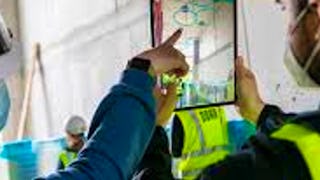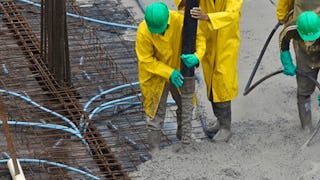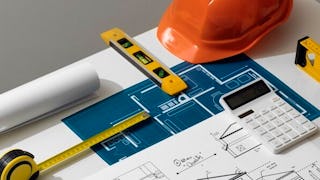Field concreting involves on-site mixing, placing, and finishing of concrete in the construction. Key steps include site preparation, concrete mixing, transportation using ready-mix trucks, placing of concrete with the help of Boom placers in the high raise buildings, compaction, finishing, curing, and quality control. Effective coordination ensures efficiency, meeting quality standards, and adhering to safety regulations during field concreting activities



Field concreting
This course is part of Mastering Concrete Techniques Specialization

Instructor: Subject Matter Expert
Included with 
Recommended experience
What you'll learn
Learn concrete placement, leveling, and compaction for precise alignment and uniform density
Master tools like screeds and floats, compaction techniques, and fixing bug holes and cold joint
Develop practical skills and problem-solving abilities for successful concrete construction
Skills you'll gain
- Construction Engineering
- Civil Engineering
- Safety Assurance
- Construction
- Vibrations
- Manufacturing Operations
- Plant Operations and Management
- Engineering, Scientific, and Technical Instruments
- Construction Management
- Structural Engineering
- Construction Inspection
- Production Process
- Commercial Construction
- Architecture and Construction
- Laboratory Testing
- Environmental Engineering
Details to know

Add to your LinkedIn profile
March 2025
5 assignments
See how employees at top companies are mastering in-demand skills

Build your subject-matter expertise
- Learn new concepts from industry experts
- Gain a foundational understanding of a subject or tool
- Develop job-relevant skills with hands-on projects
- Earn a shareable career certificate

There are 5 modules in this course
A batching plant, or concrete mixing plant, combines aggregates, cement, water, and admixtures to produce concrete in a controlled environment. It includes storage bins, conveyors, a mixer, and control equipment. Available in stationary and mobile designs, batching plants ensure consistent, high-quality concrete production, improving efficiency and quality control in construction projects. Construction equipment, including excavators, cranes, dump trucks, and concrete mixers, is essential for tasks like excavation, material transport, and surface work. Technological advancements enhance efficiency and safety, while regular maintenance ensures longevity and optimal performance
What's included
13 videos1 assignment
Formwork is essential for molding concrete into desired shapes, supporting it until it sets. Its design must consider materials, load capacity, and ease of assembly to ensure accurate reproduction of specifications and structural integrity. Effective formwork enhances versatility, cost-efficiency, and sustainability by allowing complex shapes and potential reuse
What's included
11 videos1 assignment2 plugins
Effective concrete handling in construction involves precise mix design, careful transport, proper placement, thorough compaction, and meticulous finishing and curing. Ensuring safety, quality control, and addressing environmental and weather conditions are crucial for maintaining the structural integrity and durability of the final product. Finishing shapes and smooths concrete surfaces to achieve desired textures, with precise timing being critical. Special concretes such as high-performance (HPC), fiber-reinforced (FRC), and self-compacting (SCC) cater to specific construction needs. HPC offers superior strength, FRC enhances tensile strength and crack resistance, and SCC ensures smooth finishes. These types improve performance, durability, and versatility in construction
What's included
14 videos1 assignment1 plugin
Effective construction management addresses challenges like bug holes, high-rise concrete placement, and cold joints. Mitigate bug holes with good formwork, proper mix proportions, and thorough curing. For high-rises, ensure coordinated placement, temperature control, and careful curing. Minimize cold joints through planning, surface preparation, and bonding agents. A strong quality control plan, regular inspections, training, and stakeholder collaboration are key to minimizing defects and adhering to project specifications
What's included
6 videos1 assignment
Non-destructive techniques (NDT) for concrete testing assess the material's properties without causing damage. Common methods include ultrasonic pulse velocity, which evaluates concrete density and elasticity, and ground-penetrating radar, used to locate reinforcements and detect voids. Rebound hammer tests measure surface hardness, while infrared thermography identifies thermal anomalies indicating defects. These techniques ensure the structural integrity and durability of concrete structures while maintaining their usability and safety
What's included
10 videos1 assignment
Earn a career certificate
Add this credential to your LinkedIn profile, resume, or CV. Share it on social media and in your performance review.
Instructor

Offered by
Explore more from Environmental Science and Sustainability
 Status: Free Trial
Status: Free TrialL&T EduTech
 Status: Free Trial
Status: Free TrialL&T EduTech
 Status: Free Trial
Status: Free TrialL&T EduTech
 Status: Free Trial
Status: Free TrialL&T EduTech
Why people choose Coursera for their career





Open new doors with Coursera Plus
Unlimited access to 10,000+ world-class courses, hands-on projects, and job-ready certificate programs - all included in your subscription
Advance your career with an online degree
Earn a degree from world-class universities - 100% online
Join over 3,400 global companies that choose Coursera for Business
Upskill your employees to excel in the digital economy
Frequently asked questions
Access to lectures and assignments depends on your type of enrollment. If you take a course in audit mode, you will be able to see most course materials for free. To access graded assignments and to earn a Certificate, you will need to purchase the Certificate experience, during or after your audit. If you don't see the audit option:
The course may not offer an audit option. You can try a Free Trial instead, or apply for Financial Aid.
The course may offer 'Full Course, No Certificate' instead. This option lets you see all course materials, submit required assessments, and get a final grade. This also means that you will not be able to purchase a Certificate experience.
When you enroll in the course, you get access to all of the courses in the Specialization, and you earn a certificate when you complete the work. Your electronic Certificate will be added to your Accomplishments page - from there, you can print your Certificate or add it to your LinkedIn profile. If you only want to read and view the course content, you can audit the course for free.
If you subscribed, you get a 7-day free trial during which you can cancel at no penalty. After that, we don’t give refunds, but you can cancel your subscription at any time. See our full refund policy.
More questions
Financial aid available,

